This noodle dish is a simple, meatless variation of japchae made primarily with soybean sprouts and sweet potato starch noodles.
I really think you will love this simple variation of japchae made with soybean sprouts (kongnamul, 콩나물)!
Japchae (잡채) is a Korean dish made with sweet potato starch noodles called dangmyeon (당면). The traditional dish includes thin strips of beef and various vegetables, but there are many variations! Depending on the main ingredient accompanying the noodles, the variations are called buchu (garlic chives) japchae, beoseot (mushroom) japchae, gochu (chili peppers) japchae, ueong (burdock root) japchae, kongnamul (soybean sprouts) japchae, etc.
All you need for kongnamul japchae is soybean sprouts and sweet potato starch noodles, along with a few basic seasoning ingredients. Everything else is optional! I added scallions and a little bit of red bell pepper slices for color. The ratio between the soybean sprouts and the noodles can be flexible.
How to make kongnamul japchae
To make the dish, I cook the soybean sprouts first and remove the bean sprouts. Then, use the sprout flavored cooking liquid with a little bit of the sauce to cook the noodles. By the time the noodles are cooked, all the liquid will have been absorbed by the noodles. The result is springy noodles that are shiny and flavorful!
For the traditional japchae, Korean cooks typically rinse the noodles in cold water after cooking to stop them from turning soft. However, the cooking method in this recipe keeps the noodles springy and shiny without that step.
The rest is easy! Quickly stir fry the noodles with any vegetables you’re adding, the soybean sprouts, and the remaining sauce.
One tip about cooking soybean sprouts — you can cook them either covered or uncovered. If cooking covered, do not open the lid until the sprouts are cooked, or the raw bean smell will linger even after cooked.
Feel free to dish to add a teaspoon or two of gochugaru (Korean red chili pepper flakes) to the sauce if you want to add a spicy kick.
For more Korean cooking inspirations, follow along on YouTube, Pinterest, Twitter, Facebook, and Instagram.
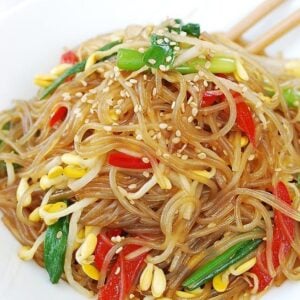
Ingredients
- 8 ounces soybean sprouts kongnamul, 콩나물
- 4 ounces Korean sweet potato starch noodles dangmyeon, 당면
- 1 teaspoon cooking oil
- 2 to 3 scallions cut into 2 inch pieces
- 1/4 red bell pepper or 1/2 small carrot, julienned
Sauce
- 2 tablespoons soy sauce
- 1 tablespoon sugar
- 1 teaspoon minced garlic
- 1 tablespoon Sesame oil
- 1/2 teaspoon Sesame seeds
- pinch pepper
Instructions
- Boil 2 cups of water in a pan over medium high heat. Add the soybean sprouts and cook for 2 minutes. Flip the sprouts over once, if cooking uncovered, for even cooking. Do not open until done if cooking covered.
- Mix all the sauce ingredients in a small bowl until the sugar is dissolved.
- Remove the soybean sprouts to a bowl, reserving the cooking liquid in the pan. Add 1 teaspoon of cooking oil, 1-1/2 tablespoons of the prepared sauce, and the noodles to the pan.
- Cook the noodles for 6 to 7 minutes until the liquid is almost gone. When the noodles turn soft, cut with kitchen shears into shorter lengths.
- Add the scallions and red pepper slices, and stir fry briefly until the vegetables are slightly wilted.
- Add the soybean sprouts and the remaining sauce. Quickly toss everything until well combined before turning off the heat.


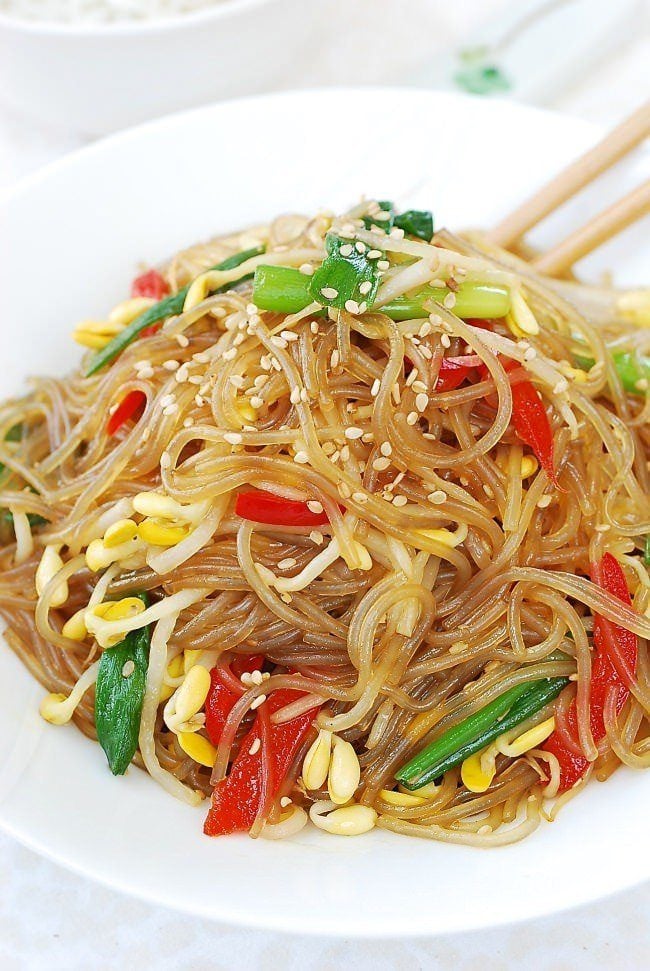

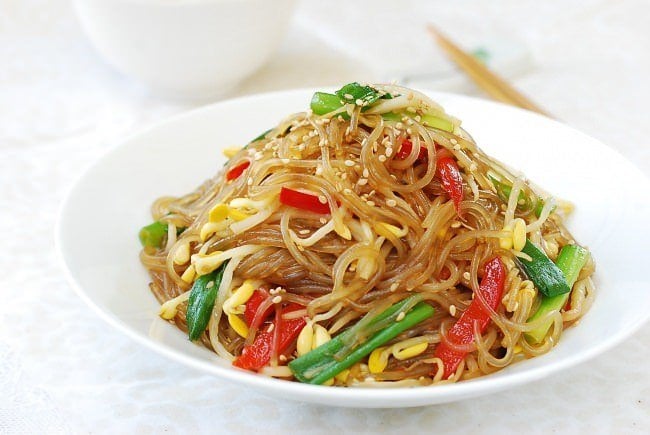
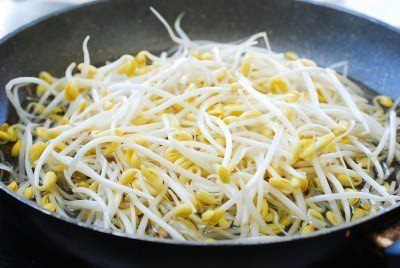
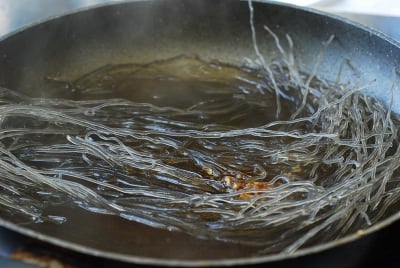
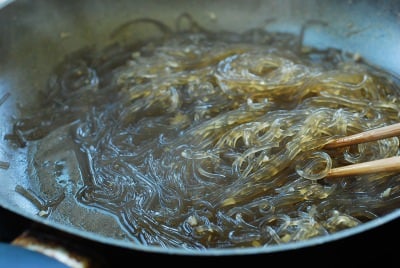
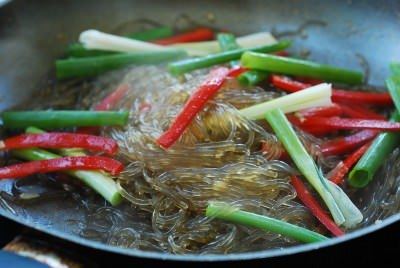
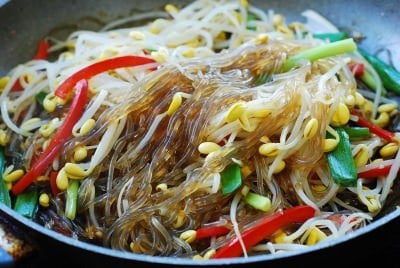
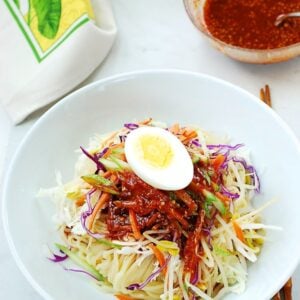

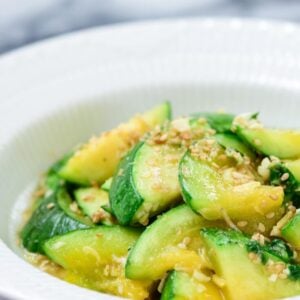
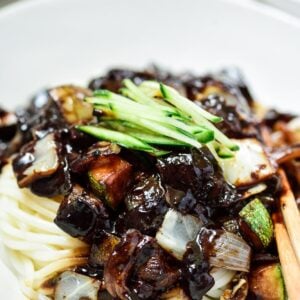

















Tiza London says
Hi –
I am making a vegan Korean lunch for my book group (we just read “Crying in H-Mart.) Can this dish be made in advance and then served at room temp?
Thanks!
Hyosun says
It should be okay, but it will be best made close to the time. The soybean sprouts will continue to release water content after being cooked and become a bit stringy. Another option is my regular japchae recipe minus the meat for a vegan japchae. Enjoy!!
Sarah says
If I double the recipe, should I double the amount of water I cook the bean sprouts in? I’m just worried that 4 cups of water would be too much for the noodles to soak up! Thanks, you’re my go-to for Korean recipes, they taste just like home!
Hyosun says
I’d think it should be okay because you’re doubling the noodles. Otherwise you might not have enough water to cook the noodles. Hope this helps.
Justin says
I am wondering if I might substitute fresh mung bean sprouts for soybean sprouts here — they are what I have, and I’d like to try the recipe!
Hyosun says
You can. Just remember mung bean sprouts takes much less time to cook.
Vic Petty says
Hi Hyuson, I was looking for Korean party food when I found your web site. I love korean food ,I love how you put the group of food for party especially for vegan.I’m having a going away party this month for a vegan friend, The video is a plus because I’m a visual person and I can remember the recipe better just by watching it. Keep up the good work and for sharing your traditional way of cooking Korean food. It’s a lot of work love , fashion and discipline.Thank you for doing it. I’m making some of your recipe , I’ll let you know how turn out .
Patricia says
Your recipes are just what I was looking for, really homemade. Thank you for sharing your authentic recipes of the delicious Korean food.
Lu Castañeda says
Hola soy Lu quería saber si me das la autorización de usar unas fotografías tuyas para un video que estoy haciendo para un concurso para viajar a Corea del sur.
Manel says
Thanks so much for this Miss Hyosun! I have loved Korean food since I began working with them. Your recipes are just wonderful!
Hyosun says
My pleasure! Thank you so much for the note!
Allison says
Anyeong hoseyo Ms Ro,
I found your blog through the Try Guys at Buzzfeed and love your recipes! I made this one tonight and it came out terrific (although I did add a good amount of gochujang to mine). Next I want to try making oi sobagi. Thank you for your wonderful blog, “Try Mom”!
Hyosun says
Ha ha Try Guys — that was so much fun! Glad to hear this turned out well for you. Hope your oi sobagi turns out well for you.